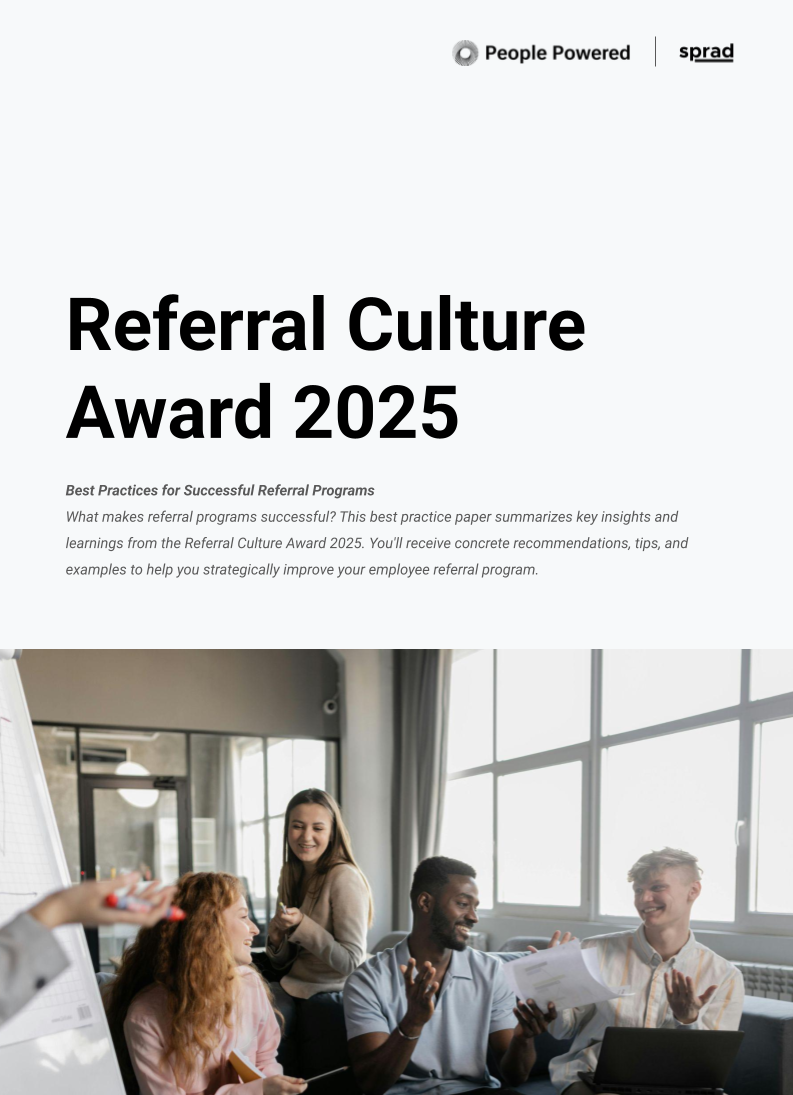A fast-growing SaaS company in Berlin recently discovered something striking: their best hires weren't coming from expensive job boards or agencies—they came from their own employees. By tracking the numbers carefully, they found that referred candidates were seven times more likely to be hired than applicants from traditional channels. The difference in cost, speed, and quality was undeniable.
In this guide, you'll get a ready-to-use employee referral ROI calculator—plus real-world benchmarks and payout models that top HR teams rely on to prove their program's value. We'll break down exactly how much money, time, and hassle you can save with referrals versus traditional hiring channels, and give you the tools to demonstrate that impact to leadership.
Here's what you'll find:
- Downloadable Excel and Google Sheets calculator for instant ROI modeling
- Pre-filled sample scenarios for 100, 250, and 500-employee companies (blue-collar and white-collar included)
- Step-by-step instructions for gathering the right data from your ATS or HRIS
- Industry benchmarks for referral participation, cost-per-hire, speed, and retention
- Comparison of flat, tiered, and staged bonus models with governance tips
Ready to see exactly how much employee referrals could boost your hiring—and your bottom line? Let's dive in.
1. Understanding Employee Referral ROI: Why It Matters
Calculating the true return on investment of your employee referral program is key to getting buy-in—and making smarter hiring decisions. When you can show leadership that referrals deliver measurable savings, faster time-to-fill, and better retention, you unlock budget and support for scaling the program.
The data backs this up powerfully. 82% of employers rate referrals as their highest ROI recruiting channel, and each successful referral hire can save up to $7,500 in costs. Referrals can fill roles 30-55% faster and cost roughly 40% less per hire compared to job boards or agencies.
Consider a mid-sized tech company tracking its hires over twelve months. After switching 25% of hires from agencies to referrals, they saw a $50,000 annual savings—without increasing their bonus payouts. The key difference was elimination of agency fees (typically 15-25% of first-year salary) and reduced vacancy costs from faster placements.
Here's how the numbers stack up across channels:
| Metric | Job Board | Agency | Referral |
|---|---|---|---|
| Avg. Time-to-Hire | 45 days | 38 days | 28 days |
| Cost Per Hire | €8,000 | €12,000 | €5,000 |
| Retention Rate (12mo) | 70% | 65% | 85% |
To build your business case, start with these steps:
- Identify your current baseline cost-per-hire and time-to-fill across all channels
- Track all hires by source in your ATS or a dedicated spreadsheet
- Factor in both direct costs (bonuses) and indirect savings (faster onboarding, reduced vacancy impact)
- Present ROI findings to leadership with concrete numbers and projected scenarios
- Revisit metrics quarterly to measure improvement and adjust your approach
The visibility you gain from tracking referral program ROI transforms hiring from a cost center into a strategic advantage. When you know the exact financial impact of each channel, you can allocate budget where it drives the most value.
So how do you actually calculate these savings? The next section walks you through the exact inputs you need.
2. Building Your Employee Referral ROI Calculator: Essential Inputs and Outputs
A practical employee referral ROI calculator needs just a handful of data points—but each one has a big impact on results. The right structure transforms raw hiring data into actionable insights about your program's financial performance.
Your calculator should capture these core inputs: open roles filled, number of referral hires, time-to-hire delta between channels, conversion rates by source, cost-per-hire differences, your payout structure, administrative time and costs, and participation rates. When you combine these variables, you get a complete picture of referral program economics.
The math is revealing. Referral-to-hire conversion rates are often seven times higher than job board applicants. This efficiency translates directly to lower recruiting costs and faster placements.
A hypothetical manufacturing company with 250 employees used the calculator to compare agency versus referral costs for blue-collar roles. They found a €2,000 bonus still produced a net saving of €5,000 per hire due to faster onboarding (reducing overtime costs for existing staff) and elimination of agency fees.
Here's a typical input structure:
| Input | Example Value |
|---|---|
| Open Roles This Year | 30 |
| Hires via Referrals | 8 |
| Avg. Referral Bonus | €2,000 |
| Avg. CPH – Agency | €10,000 |
| Time-to-Fill Reduction | 15 days |
Your calculator should generate these critical outputs: total savings versus baseline, payback period, referral hire quality and retention lift, and customer acquisition cost per hire. These metrics tell the complete story—not just immediate savings but long-term value.
Follow these steps to populate your calculator:
- Gather open role counts and hires by source from your ATS
- Measure average days-to-fill per channel (referral vs job board vs agency)
- Calculate cost-per-hire by including advertising fees, agency commissions, plus bonus and admin costs
- Record number of employees actively participating in the program
- Input all figures into the downloadable template for instant output and scenario modeling
The calculator becomes especially powerful when you track additional factors like vacancy cost. For a sales role generating €500 daily revenue, a 15-day faster fill saves €7,500—often more than the referral bonus itself. This is where the real ROI multiplier lives.
Once your data is ready, let's see what industry benchmarks look like—and how your numbers stack up.
3. Real Benchmark Data for Employee Referral Programs: Participation Rates, Conversion, and Savings
Benchmarks help set realistic targets—and show whether your referral program is underperforming or excelling. Without context, you can't judge if 20% referral hires is solid or subpar for your industry and company size.
Globally, structured referral programs typically account for 25-50% of total hires. Studies across Asia and Europe consistently show this range, with best-in-class programs pushing above 40%. Time-to-fill reductions of 30-55% are common, and quality improvements measure around 40-45% higher retention compared to other channels.
Best-in-class programs deliver roughly €28 ROI for every euro spent on bonuses. This exceptional return stems from multiple factors: lower direct costs, faster placements reducing vacancy impact, and significantly better retention reducing replacement costs.
A Swiss industrial firm increased frontline participation from under 10% to nearly 40% after launching WhatsApp-based referral campaigns. They achieved this by sending voice messages directly to shift workers' phones and posting visual job cards at clock-in stations. The result? They tripled qualified blue-collar referrals within six months, dramatically reducing reliance on expensive temp agencies.
Use these steps to benchmark your program:
- Compare your percentage of hires from referrals against the typical range (25-50%)
- Set specific goals for improving participation, especially among hard-to-reach roles or locations
- Track quality metrics like retention at one year, comparing referral hires to other sources
- Use benchmark cost-per-hire ranges (€5,000-€8,000 for referrals vs €10,000+ for agencies)
- Present both dollar savings and process improvements when reporting to leadership
Here's how typical programs perform:
| Benchmark Metric | Typical Range |
|---|---|
| Referral Share of Hires | 25-50% |
| Time-to-Fill Reduction | 30-55% |
| Bonus per Hire | €1,000-€3,000 |
| Retention Uplift | 40-45% |
The participation rate deserves special attention. If only 15% of your workforce has ever made a referral, you're leaving money on the table. High-performing programs see 30-50% of employees referring at least once per year. The difference usually comes down to communication strategy and process simplicity, not bonus amounts.
Curious about which payout model actually works best? Let's break down the options next.
4. Payout Models Compared: Flat vs Tiered vs Staged Bonuses
The right bonus structure can boost engagement—and protect against poor fit hires or early churn. Your payout model directly influences both participation rates and the quality of referrals you receive.
Three main models dominate the market. Flat bonuses pay the same amount for any successful referral hire—simple but potentially wasteful for roles with different recruiting difficulty. Tiered bonuses adjust amounts based on role level or scarcity, directing referrals toward your hardest-to-fill positions. Staged payouts split the bonus into installments tied to milestones like hire date and completion of probation.
Research reveals staged payouts deliver tangible retention benefits. Companies splitting bonuses (half at hire, half after six months) reduce first-year attrition by up to 26%. A Swiss services company made exactly this switch—from flat €2,000 upfront to staged €1,000 at hire plus €1,000 after six months—and cut early attrition by one third over twelve months.
The psychology is straightforward. When referrers know their second payment depends on the candidate staying, they think harder about long-term fit before submitting a name. This self-selection improves quality without increasing your total payout.
| Model | Upfront Payout? | After Probation? | Best For |
|---|---|---|---|
| Flat | Yes | No | Fast/simple cases |
| Tiered | Varies | Varies | Critical/hard roles |
| Staged | Partial | Partial | Reducing early attrition |
Consider these implementation steps:
- Flat bonuses are simple but may not incentivize long-term fits or focus on priority roles
- Tiered bonuses reward harder-to-fill or senior positions appropriately (€3,000+ for specialized roles vs €1,500 for entry-level)
- Staged payouts align incentives with retention milestones—typically 50/50 split at hire and after probation
- Always document payout rules clearly in policy templates and communicate them repeatedly
- Consider taxation impact—net payout may differ significantly by country, especially in DACH regions
One practical consideration: 63% of employees say they need clear rules before participating in a referral program. Complexity kills participation. If you implement tiered or staged models, invest equally in communication—explaining exactly when and how much people will receive.
For DACH countries specifically, remember that referral bonuses are taxed as regular income in Germany, Austria, and Switzerland. A €2,000 gross bonus might net only €1,200-€1,400 after taxes and social charges. Factor this into your payout levels to ensure the net amount still motivates.
But even the best-designed program needs solid processes behind it—so how do you collect clean data?
5. Collecting Accurate Data From Your ATS or HRIS
Accurate ROI calculation depends on clean hiring data—which most modern ATS platforms can provide if you know where to look. The challenge isn't technology capability; it's consistent process and discipline around data entry.
Most systems allow tagging hires by source channel. The key is ensuring every referral submission gets flagged correctly from the start. When you match this source data with payroll information (bonuses paid) and performance data (retention outcomes), you get full visibility on spend versus outcome.
Companies that regularly review these numbers uncover substantial efficiency gains. Proper automation can reclaim up to 50% of admin time previously spent on manual tracking and reporting. A global retailer automated its source tracking using custom fields in their ATS—reducing manual reporting errors and reclaiming three hours per week for their recruiting team.
Here's your data collection roadmap:
- Pull a report of all hires over the last year by source channel from your ATS
- Ensure "referral" submissions are flagged consistently—create a standard workflow that auto-tags them
- Compare funnel metrics (applications, interviews, offers) across sources to calculate conversion rates
- Cross-check bonus payments against payroll records to verify actual costs
- Regularly audit data accuracy before using it in calculations—quarterly reviews catch tagging errors early
| Data Source | Field Needed | Frequency |
|---|---|---|
| ATS | Source Channel Tag | Ongoing |
| Payroll System | Bonus Payments | Quarterly |
| HRIS | Retention Outcomes | Annually |
The most common data quality issue is inconsistent source attribution. When multiple touchpoints exist (candidate applies through job board but mentions a referral in their cover letter), establish clear rules. Best practice: the first recorded touchpoint wins, unless the referrer submitted the candidate through your official referral portal before the application.
For retention tracking, pull termination data at 6-month and 12-month marks. Filter by hire source to compare referral versus non-referral tenure. This becomes your quality multiplier in the ROI calculator—higher retention means lower replacement costs and higher lifetime value per hire.
One technical tip: if your ATS doesn't natively track referral source well, create a custom field or use candidate tags. Some teams use a simple naming convention in the application source dropdown: "Referral - [Employee Name]" ensures both attribution and traceability.
With inputs collected and models chosen—it's time for hands-on calculation. Here's how it works step-by-step.
6. Step-by-Step Walkthrough: Using the Employee Referral ROI Calculator
Plugging real numbers into an interactive calculator instantly shows whether your employee referral program delivers financial value—or where it needs work. Let's walk through a practical example using realistic scenarios.
The calculator includes pre-filled scenarios for different organization sizes and workforce types. You'll find tabs for 100, 250, and 500 headcount organizations, plus specific examples for blue-collar roles using WhatsApp-based referral flows versus white-collar positions using email and Slack.
Even small firms can save tens of thousands annually. A 100-employee company that redirects just five hires from agencies to referrals—assuming €8,000 agency cost versus €3,000 total referral cost (€2,000 bonus plus €1,000 admin)—saves €25,000 in year one alone.
Let's work through a concrete example. Suppose you're an HR manager at a tech firm with these figures:
- Open roles per year: 25
- Hires via referrals: 6
- Average bonus paid out: €2,000
- Agency cost-per-hire baseline: €9,000
- Actual cost-per-hire via referrals (including admin and bonus): €5,000
- Time saved per fill: average two weeks per hire (€200 daily revenue impact)
When you enter these numbers, the calculator outputs: Net savings per year of €24,000, payback period under three months, and quality uplift of +15% based on retention data. The two-week faster fill across six hires saves an additional €16,800 in vacancy costs (6 hires × 14 days × €200/day).
| Scenario Size | Annual Hires via Referrals | Estimated Net Savings |
|---|---|---|
| Small (100 staff) | 5 | €15,000 |
| Medium (250 staff) | 12 | €35,000 |
| Large (500 staff) | 30 | €80,000+ |
Follow these steps in the calculator:
- Enter open positions and number hired through referrals in the input section
- Add average agency or job board cost-per-hire as your baseline comparison
- Input total paid bonuses plus estimated administrative costs (platform fees, HR time)
- Adjust participation rate slider for scenario planning—see how 20% vs 40% participation changes outcomes
- Review instant outputs showing total savings, payback period, cost per acquisition, and retention impact
For DACH countries, the calculator includes a note about taxation on bonuses. In Germany and Switzerland, all cash bonuses are taxed as regular income and subject to social charges. In Austria, small gifts under €186 per year are tax-free, but cash bonuses above that threshold are taxed. Always check local payroll and tax rules—the calculator provides a disclaimer reminding you to verify with your finance team.
The blue-collar scenario tab demonstrates different economics. A manufacturing company using WhatsApp for referrals might see lower bonuses (€1,500) but dramatically higher participation (50% of workforce) because the submission process requires just a text message with a candidate's contact info. The volume compensates for the slightly lower per-hire savings. See the dedicated guidance for non-desk workflows in the blue-collar context here.
Now that you've calculated potential returns—it pays to keep optimizing. What governance practices separate good referral programs from great ones?
7. Governance and Best Practices for Sustainable Employee Referral Programs
Long-term success means strong rules against fraud and conflicts—and communication strategies that make everyone want to participate. The difference between a program that fizzles and one that thrives often comes down to governance and process design.
Programs requiring written consent and data clarity see up to 63% more participation. People won't refer candidates if they're unclear about how personal data gets used or whether they're violating someone's privacy. Transparency builds trust, and trust drives engagement.
Communication channels matter enormously. Upfront communication via WhatsApp or printed posters tripled blue-collar engagement rates at one Swiss plant. The lesson? Meet employees where they already spend time. Office workers check Slack; warehouse workers don't. Adapt your channels accordingly.
A German logistics firm banned managers from referring their direct reports—and saw improved fairness plus zero fraud cases over two years post-policy update. This simple rule eliminated the most common conflict of interest and protected the company from claims of favoritism.
| Governance Measure | Impact / Rationale |
|---|---|
| Written Consent Required | Legal compliance and trust |
| Manager Referrals Prohibited | Prevents conflicts |
| Data Transparency Policy | Boosts participation |
| Automated Status Updates | Keeps referrers engaged |
| Regular KPI Reviews | Drives continuous improvement |
Implement these best practices to build a sustainable program:
- Require explicit referrer and candidate consent under GDPR and local data protection laws
- Prohibit managers or HR from referring candidates they directly oversee or interview
- Define referral validity periods (typically six months) to manage expectations
- Use multi-channel communications—email, Slack, WhatsApp, physical posters—to reach different employee segments
- Solicit feedback regularly through quick surveys to improve usability and rule clarity
Automation reduces administrative burden dramatically. Platforms that auto-update referrers on candidate status (application received, interview scheduled, offer made) cut admin time by roughly 50%. This keeps referrers engaged throughout the process and removes the need for them to chase HR for updates.
One often-overlooked governance element: diversity considerations. Referrals naturally pull from existing employee networks, which can perpetuate homogeneity if unchecked. Counter this by explicitly asking referrers to consider diverse candidates, partnering with affinity groups to spread awareness, and tracking diversity metrics separately for referred versus non-referred hires.
Define clear rules around referral conflicts. For example: candidates can't be referred by multiple employees (first recorded referral gets credit), referrals of former employees may require manager approval, and referrals for highly sensitive roles may be restricted. Document these exceptions in your policy.
Regular measurement drives improvement. Set quarterly reviews of key metrics: referral-to-hire conversion rate, cost per referral hire versus baseline, participation rate by department, and retention rates of referred employees. Share these numbers with employees to build momentum and show program impact.
Let's recap what matters most as you move forward with smarter hiring through referrals.
Conclusion: Employee Referrals Deliver Measurable Value When Backed By Data
A well-built employee referral program consistently saves money and fills roles faster than any other channel. The evidence is overwhelming: referred candidates convert at seven times the rate of job board applicants, stay 25-45% longer, and cost 40% less to hire when you factor in all expenses.
Structured ROI calculation—using clear inputs like cost-per-hire deltas and retention outcomes—is essential for ongoing optimization. Without numbers, you're guessing. With them, you can demonstrate value to leadership, secure budget, and refine your approach based on what actually works.
The most successful programs combine smart incentive design with strong governance and transparent communication across all levels of staff. Staged bonuses protect against early churn. Clear policies prevent conflicts and fraud. Multi-channel communication reaches everyone from executives to frontline workers.
Next Steps For HR Teams
- Download the free Excel or Google Sheets calculator and customize it for your organization
- Pull recent hiring data from your ATS and payroll system to establish your baseline
- Run scenario analyses using pre-filled examples tailored to your workforce type and company size
- Present findings internally with concrete savings projections and adjust policies or payouts based on what works best for your culture
As talent shortages persist globally and technology evolves rapidly, data-driven employee referral programs will become even more central to competitive hiring strategies. AI-matched referrals, mobile-first submission flows, and predictive analytics around referral quality are already emerging. Organizations that build measurement discipline now will be positioned to leverage these advances as they mature.
For additional resources on referral program tools and platform comparisons, see our guide to the Best Employee Referral Software.
Frequently Asked Questions (FAQ)
How do I use an employee referral ROI calculator effectively?
Start by collecting accurate data on hires made through referrals versus other channels—including all costs like bonuses paid out and reduced vacancy days. Plug these numbers into an Excel or Google Sheets template designed for employee referral program analysis. The tool will instantly show total savings versus baseline recruiting spend along with key metrics like payback period, cost per acquisition, and quality uplift based on retention data. Make sure you're comparing apples to apples: include agency fees, job board advertising costs, and internal recruiter time in your baseline, then measure referral costs including bonuses, admin time, and platform fees if applicable. Review outputs quarterly and adjust your program based on what the data reveals.
What's a typical bonus amount paid out in successful employee referral programs?
Most companies offer between €1,000 and €3,000 per successful hire, with higher amounts (€5,000 or more) reserved for hard-to-fill or executive roles. Industry data shows competitive bonuses often range from €1,000 to €5,000 depending on role level and market conditions. Aligning payout levels with actual cost-per-hire reductions ensures high motivation without overspending on rewards. For specialized technical roles or senior leadership positions, bonuses can reach €10,000 or higher—but the key is ensuring the total referral cost still comes in well below agency fees or other recruiting expenses. Staged payouts (half at hire, half after probation) are increasingly popular because they reduce early attrition while keeping total bonus amounts attractive.
Why is my employee participation rate lower than benchmark averages?
Low engagement often results from unclear processes or lackluster communication—not necessarily weak incentives. Make sure jobs are easy to refer via mobile, email, or chat apps. Publicize open positions frequently through multiple channels. Share success stories internally showing real employees who received bonuses and helped colleagues join. Consider running contests or offering non-cash perks alongside cash bonuses if needed. Research shows 59% of employees would refer more if rules were simpler and clearer. The submission process should take under two minutes. If employees need to log into a separate portal, fill out long forms, or don't know which roles are open, participation will suffer regardless of bonus amounts. Meet employees where they already work—integrate referral submissions into Slack, Teams, WhatsApp, or email rather than forcing them to use standalone systems.
How does staging payouts improve retention among referred hires?
Staged payouts divide the total bonus into installments—for example half at start date plus half after passing probation—which aligns referrer motivation with long-term fit rather than just initial placement. This approach has been shown to cut early turnover by up to 26%. When referrers know their second payment depends on the candidate staying, they think harder about long-term fit before submitting a name. This self-selection improves quality without increasing your total payout. A Swiss services company that switched from flat €2,000 upfront bonuses to staged €1,000 at hire plus €1,000 after six months cut churn in the first year by one third. The psychology is simple but powerful: delayed gratification creates better alignment between company goals and employee incentives.
What are some risks or downsides when using an employee referral ROI calculator?
The main pitfalls include incomplete or inaccurate input data, and ignoring indirect effects like diversity impacts or administrative overheads. If your ATS doesn't consistently tag referral sources, your baseline numbers will be wrong. Always audit source tags carefully in your HR systems before drawing conclusions. Another risk is over-optimizing for short-term cost savings while missing quality signals—if referred hires churn quickly, the apparent cost savings disappear when you factor in replacement costs. Update your assumptions as market conditions shift. What worked pre-pandemic may not reflect current recruiting dynamics. Finally, remember that correlation doesn't prove causation: referred candidates may perform better partly because of self-selection (people only refer strong candidates) rather than the referral relationship itself. Use the calculator as one input to decision-making, not the only one.












